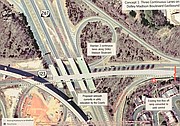Around eighty concerned citizens gathered at the McLean Community Center on Thursday, June 13 to hear about the short and long term plans the Fairfax County Department of Transportation is developing to combat troubling traffic patterns in the Dolley Madison corridor in McLean.
The community meeting was held by Supervisor John Foust and Fairfax County Department of Transportation, with a presentation led by Gregg Steverson, the Division Chief for oversight analysis and transportation planning for FCDOT.
The Dolley Madison Corridor Study is analyzing the area of Dolley Madison Boulevard specifically between the Dulles Toll Road and Old Dominion Drive, and provide solutions to improve existing traffic conditions and anticipated future problems.
Steverson stressed community opinion and response as a main concern of the study, hoping to gain insight into how community members at large will respond to changes set in place within the next ten years or so.
The study stems from an existing Tysons neighborhood study that evaluated thirty intersections surrounding Tysons to “provide potential future mitigations.” The information gathered through this analysis showed a need for significant improvements at these locations.
THE DOLLEY MADISON CORRIDOR STUDY looks at six main intersections in the area: Dolley Madison Boulevard and Great Falls Street and Lewinsville Road, Dolley Madison Boulevard and Old Dominion Drive, Dolley Madison Boulevard and Ingleside Avenue, Balls Hill Road and Lewinsville Road, Chain Bridge Road and Great Falls Street, and Old Dominion Drive and Ingleside Avenue.
Before discussing any potential plans, Steverson addressed existing conditions in these areas. Using the qualitative measure of Level of Service (LOS) to show the average delay at a given intersection, FCDOT has described conditions in these intersections using the common “school grade” designation (A through F).
“Along the corridor, in the AM conditions weren’t terrible,” Steverson noted. “For the most part, conditions were at a ‘D’ or better.” The same could not be said for PM conditions, however, with many intersections in the “heavy ‘F’ territory.”
Six short-term corridor improvement concepts along with their benefits and drawbacks were presented to address existing conditions and help ten or so years into the future. These concepts are specifically focused on traffic signals, turn lanes, and markings based on 2027 traffic forecasts.
Concept 1 implements three continuous lanes on Dolley Madison Boulevard Eastbound. Benefits include gaining an additional eastbound through lane on Dolley Madison and avoiding a lane merge east of EB Toll Road off ramp. Drawbacks include removal of trees within the median, potential for bottleneck around Great Falls/Lewinsville intersection, and free flow merge conditions from WB toll road off-ramp to NB Dolley Madison becoming a yield condition.
The presentation briefly touched on interchange improvement concepts for discussion into long-term solutions, as the short-term changes will provide improvements, but not permanent solutions.
Using 2027 traffic forecasts, FCDOT explores three scenarios regarding interchanges: No-Build; Alternative 1, an interchange at Lewinsville/Great Falls; and Alternative 2, interchanges at both Lewinsville/Great Falls and Old Dominion. The analysis results showed shorter queuing times at the intersections, thus improving traffic patterns.
A community member expressed concern about the implementation of these interchanges, wondering how speeding up through traffic on Dolley Madison would impact traffic further down in the Tysons area.
“This particular project stops basically around the toll road,” Steverson clarified.
“There’s another project that also works on the Tysons area on 123, from Anderson over to International.”
STEVERSON also assured the community that his team is in close contact with the other project, assuring that they are “on the same page” when analyses are conducted and changes implemented.
A few community members questioned how they might judge these plans without any indication of their costs.
“The thought process is, if the desire is to move forward with something, we would get to the feasibility stage,” Steverson responded. “Right now we’re truly in the early-stage, analytical phase to get an idea of what helps and what doesn’t help.”
Community members showed concern for certain aspects of the presentation, but there was a shared sense of necessity for change.
FCDOT strongly encourages feedback from the community, and will post a survey to their website. They hope to receive significant feedback by July 15. See www.fairfaxcounty.gov/transportation/study/dolley-madison-corridor
